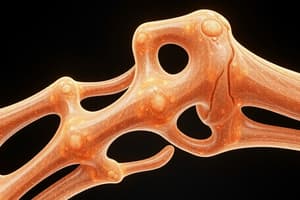Podcast
Questions and Answers
Which type of bone healing involves direct bone production with minimal to no instability at the fracture site?
Which type of bone healing involves direct bone production with minimal to no instability at the fracture site?
- Primary (Direct) (correct)
- Tertiary
- Quaternary
- Secondary (Indirect)
What regions receives the predominant amount of blood supply for fractured bone early in the healing process?
What regions receives the predominant amount of blood supply for fractured bone early in the healing process?
- Periosteal supply (correct)
- Afferent supply
- Endosteal supply
- Centrifugal supply
What are the essential factors for bone healing outlined in the text?
What are the essential factors for bone healing outlined in the text?
- Inflammatory and autoimmune factors
- Local and systemic factors (correct)
- Environmental and psychological factors
- Hormonal and genetic factors
Which type of bone ossification forms from cartilage, is involved in secondary bone healing, and seen at the growth plates
Which type of bone ossification forms from cartilage, is involved in secondary bone healing, and seen at the growth plates
What is the function of osteoblasts in bone healing?
What is the function of osteoblasts in bone healing?
Which factor is listed as contributing to bone healing in the text?
Which factor is listed as contributing to bone healing in the text?
What is disrupted initially in the blood supply of fractured bone?
What is disrupted initially in the blood supply of fractured bone?
What are the types of bone grafts described in the text?
What are the types of bone grafts described in the text?
What is the term for the balanced function of osteoblasts and osteoclasts at the fracture site?
What is the term for the balanced function of osteoblasts and osteoclasts at the fracture site?
What is the term for the inner 2/3 of the cortex's blood flow in intact bone?
What is the term for the inner 2/3 of the cortex's blood flow in intact bone?
What is the primary source of bone graft with the best osteogenic potential?
What is the primary source of bone graft with the best osteogenic potential?
Which property of bone graft involves the promotion of progenitor migration and proliferation?
Which property of bone graft involves the promotion of progenitor migration and proliferation?
What is the primary etiology of implant associated osteomyelitis?
What is the primary etiology of implant associated osteomyelitis?
Which scenario is most likely to reduce healing complications in bone fractures?
Which scenario is most likely to reduce healing complications in bone fractures?
What is the recommended treatment approach for implant associated osteomyelitis?
What is the recommended treatment approach for implant associated osteomyelitis?
Which factor significantly affects bone healing and may lead to non-union?
Which factor significantly affects bone healing and may lead to non-union?
What is the primary role of osteopromotion in bone graft properties?
What is the primary role of osteopromotion in bone graft properties?
Which radiographic sign can be hard to distinguish from normal healing in implant associated osteomyelitis?
Which radiographic sign can be hard to distinguish from normal healing in implant associated osteomyelitis?
What is the primary postoperative strategy to facilitate bone healing in the presence of osteomyelitis?
What is the primary postoperative strategy to facilitate bone healing in the presence of osteomyelitis?
What is the primary surgical strategy to reduce healing complications in bone fractures?
What is the primary surgical strategy to reduce healing complications in bone fractures?
Which type of bone healing involves the formation of callus and bone remodeling?
Which type of bone healing involves the formation of callus and bone remodeling?
What tissues are involved in secondary (indirect) bone healing?
What tissues are involved in secondary (indirect) bone healing?
Which process involves continuous osteoblast-osteoclast function and occurs along the lines of stress?
Which process involves continuous osteoblast-osteoclast function and occurs along the lines of stress?
How is the assessment of bone healing based?
How is the assessment of bone healing based?
What can malunion have long-term impacts on?
What can malunion have long-term impacts on?
What can cause delayed union?
What can cause delayed union?
What is the treatment approach for delayed union focused on?
What is the treatment approach for delayed union focused on?
How can non-union be classified based on biologic activity?
How can non-union be classified based on biologic activity?
What are the further sub-classifications of avascular (non-viable) non-union based on?
What are the further sub-classifications of avascular (non-viable) non-union based on?
What is the basis of assessment for bone healing?
What is the basis of assessment for bone healing?
Flashcards are hidden until you start studying
Study Notes
Bone Healing and Complications
- Different types of bone healing: primary (direct) gap healing, primary (direct) contact healing, and secondary (indirect) bone healing
- Primary gap healing involves the formation of callus and bone remodeling
- Tissues involved in secondary (indirect) bone healing include hematoma, granulation tissue, connective tissue, fibrocartilage, cartilage, and mineralized bone
- Types of ossification: endochondral ossification, intramembranous ossification, and distraction osteogenesis
- Bone remodeling occurs along the lines of stress (Wolff’s law) and involves continuous osteoblast-osteoclast function
- Assessment of bone healing is based on orthogonal radiographs and the "4A’s of fracture assessment" (apposition, alignment, apparatus, activity)
- The assessment of bone healing requires standard orthogonal views, optimal machine settings, and optimal patient positioning
- Malunion can have long-term impacts on adjacent joints and may require corrective osteotomy/ostectomy treatment
- Delayed union can be caused by local factors, stability factors related to constructs, and systemic factors
- Treatment of delayed union involves early detection, identifying causes, addressing underlying causes, and preventing progression to non-union
- Non-union can be vascular (viable) or avascular (non-viable), with different sub-classifications based on callus volume and biologic activity
- Avascular (non-viable) non-union can be further sub-classified as dystrophic or necrotic, based on biologic activity at a cellular level
Studying That Suits You
Use AI to generate personalized quizzes and flashcards to suit your learning preferences.



